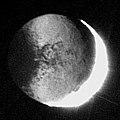File:Iapetus by Saturnlight.jpg
Iapetus_by_Saturnlight.jpg (400 × 400 pixels, file size: 35 KB, MIME type: image/jpeg)
Captions
Captions
Summary[edit]
| Target Name: | Iapetus |
| Is a satellite of: | Saturn |
| Mission: | Cassini Orbiter |
| Spacecraft: | Cassini Orbiter |
| Instrument: | Imaging Science Subsystem - Narrow Angle |
| Product Size: | 400 samples x 400 lines |
| Produced By: | CICLOPS/Space Science Institute |
| Primary Data Set: | Cassini |
| Full-Res TIFF: | PIA06146.tif (156.9 KB) |
| Full-Res JPEG: | PIA06146.jpg (22.82 KB) |
Seeing in the Dark
New details on Iapetus are illuminated by reflected light from Saturn in this revealing Cassini image. Never-before-seen features on the Saturn-facing part of Iapetus' bright trailing hemisphere are visible for the first time, including many dark spots, and a sharper view of a dark, circular structure that was first seen at very low resolution by NASA's Voyager 1 in 1980. Iapetus diameter is 1,436 kilometers (892 miles).
The image shows mainly the night side of Iapetus; part of the far brighter sunlit side appears at the right and is overexposed due to the long integration time of 180 seconds. Despite this long exposure time, almost no blurring due to the spacecraft's motion is apparent. This technique for imaging the night side of Iapetus will be used again during a flyby on Jan. 1, 2005, when Cassini will pass 13 times closer to the icy moon.
The image was taken in visible light with the Cassini spacecraft narrow angle camera on Oct. 22, 2004, at a distance of 1.6 million kilometers (994,000 miles) from Iapetus, and from a Sun-Iapetus-spacecraft, or phase, angle of 161 degrees. The view is centered on 0.4 degrees north latitude, 317 degrees west longitude on Iapetus. The image scale is 9.4 kilometers (5.8 miles) per pixel.
The Cassini-Huygens mission is a cooperative project of NASA, the European Space Agency and the Italian Space Agency. The Jet Propulsion Laboratory, a division of the California Institute of Technology in Pasadena, manages the Cassini-Huygens mission for NASA's Office of Space Science, Washington, D.C. The Cassini orbiter and its two onboard cameras, were designed, developed and assembled at JPL. The imaging team is based at the Space Science Institute, Boulder, Colo.
Source: http://photojournal.jpl.nasa.gov/catalog/PIA06146 (direct link)
This image or video was catalogued by Jet Propulsion Laboratory of the United States National Aeronautics and Space Administration (NASA) under Photo ID: PIA06146. This tag does not indicate the copyright status of the attached work. A normal copyright tag is still required. See Commons:Licensing. Other languages:
العربية ∙ беларуская (тарашкевіца) ∙ български ∙ català ∙ čeština ∙ dansk ∙ Deutsch ∙ English ∙ español ∙ فارسی ∙ français ∙ galego ∙ magyar ∙ հայերեն ∙ Bahasa Indonesia ∙ italiano ∙ 日本語 ∙ македонски ∙ മലയാളം ∙ Nederlands ∙ polski ∙ português ∙ русский ∙ sicilianu ∙ slovenščina ∙ Türkçe ∙ українська ∙ 简体中文 ∙ 繁體中文 ∙ +/− |
Licensing[edit]
| Public domainPublic domainfalsefalse |
| This file is in the public domain in the United States because it was solely created by NASA. NASA copyright policy states that "NASA material is not protected by copyright unless noted". (See Template:PD-USGov, NASA copyright policy page or JPL Image Use Policy.) |  | |
 |
Warnings:
|
File history
Click on a date/time to view the file as it appeared at that time.
| Date/Time | Thumbnail | Dimensions | User | Comment | |
|---|---|---|---|---|---|
| current | 03:04, 19 December 2015 |  | 400 × 400 (35 KB) | PlanetUser (talk | contribs) | converted from TIFF |
| 18:20, 4 April 2005 |  | 400 × 400 (22 KB) | Smartech~commonswiki (talk | contribs) | Iapetus, a moon of Saturn, with its dark side illuminated by reflected light from Saturn {{PD-USGov-NASA}} '''Original caption released with image:''' New details on Iapetus are illuminated by reflected light fro |
You cannot overwrite this file.
File usage on Commons
The following 2 pages use this file:
File usage on other wikis
The following other wikis use this file:
- Usage on ar.wikipedia.org
- Usage on bg.wikipedia.org
- Usage on ca.wikipedia.org
- Usage on fr.wikipedia.org
- Usage on ko.wikipedia.org
- Usage on lv.wikipedia.org
- Usage on ms.wikipedia.org
- Usage on sv.wikipedia.org
- Usage on zh.wikipedia.org
Metadata
This file contains additional information such as Exif metadata which may have been added by the digital camera, scanner, or software program used to create or digitize it. If the file has been modified from its original state, some details such as the timestamp may not fully reflect those of the original file. The timestamp is only as accurate as the clock in the camera, and it may be completely wrong.
| Width | 400 px |
|---|---|
| Height | 400 px |
| Compression scheme | LZW |
| Pixel composition | Black and white (Black is 0) |
| Number of components | 1 |
| Number of rows per strip | 1 |
| Data arrangement | chunky format |
| Software used | VICAR Program VTIFF |
| File change date and time | 06:00, 8 December 2004 |
